Within the last years, the rivalry between Borussia Dortmund and Bayern Munich became the most important one in Germany since these two were clearly the two best sides in the Bundesliga. Furthermore, in the season 2012/13, these two teams met in the final of the UEFA Champions League and it was for the first time in the history of Europe’s most important competition a final with two German sides. Also, within the last decade, these two teams were the ones who dominated the Bundesliga. 2008/09 was the last season in which the champions after the 34th weren’t Borussia Dortmund or Bayern Munich as back then Wolfsburg won. Since then, Bayern won it eight times and Dortmund twice.
However, in this season, there are with RB Leipzig, Borussia Mönchengladbach and Bayer Leverkusen three other teams who are extremely strong and we have an open and interesting race for the title.
In this tactical analysis in the form of a preview, we will look at the two games of each Bayern and BVB since the restart of the Bundesliga and with the aid of this, we will speculate how the direct clash between them on the 28th matchday could look like.
Their line-ups
Hansi Flick went in the last two games with a 4-2-3-1 formation and used in both matches the same back four in front of Manuel Neuer which consisted of Alphonso Davies, David Alaba, Jérôme Boateng and Benjamin Pavard. The double-pivot consisted in the first game after the restart against Union Berlin out of Joshua Kimmich and Thiago while in the last match against Eintracht Frankfurt Leon Goretzka was the partner of Kimmich. Also, Robert Lewandowski was logically in both matches the single striker while the three offensive ones were against Union Thomas Müller, Serge Gnabry and Goreztka while in the game versus Adi Hütter’s side Müller was supported by Kingsley Coman and Ivan Perišić.
While Thiago was out in the last match against Frankfurt due to a little injury and it is yet not sure if he can play against BVB, it seems like Flick wanted to rotate a bit in the last game to give Gnabry a break and the wingers Coman and Perišić a chance to prove their qualities. Considering this, it is hard to say who the partner of Kimmich in front of the back four (which will surely stay the same unless someone gets injured as Flick noted a few days ago) will be and which two men will support Müller behind Lewandowski. Of course, Thiago will play if he is fit, but we will have to wait and see.
On the other side, Lucien Favre lined up his team in the two games since the restart in the 3-4-3 and 3-4-2-1 respectively which they primarily use since the end of November 2019. In these two games, the starting XI was exactly the same with Roman Bürki in goal and the back three was made of Manuel Akanji, Mats Hummels and Łukasz Piszczek. Mahmoud Dahoud and Thomas Delaney played in the central midfield (Axel Witsel is injured and Emre Can missed the game against Schalke due to muscular problems and got subbed on against Wolfsburg in the last game as Hummels got injured). The wing-backs were Raphaël Guerreiro and Achraf Hakimi. Julian Brandt and Thorgan Hazard supported upfront the Norwegian striker Erling Haaland.
Jadon Sancho (who is linked with Manchester United and several other big clubs in Europe) had also muscular problems before the restart and therefore just got subbed on in the last two games, but both times performed well. Due to that, it will be hard for Favre to decide if he uses the same front three or adds Sancho. Also, Witsel and Can both could probably be fit again while Hummels might be out for the game against Bayern due to his injury. In the shot below we can see how the two teams might start the game as they will surely stick with their respective formations, but the coaches have in some positions several options.
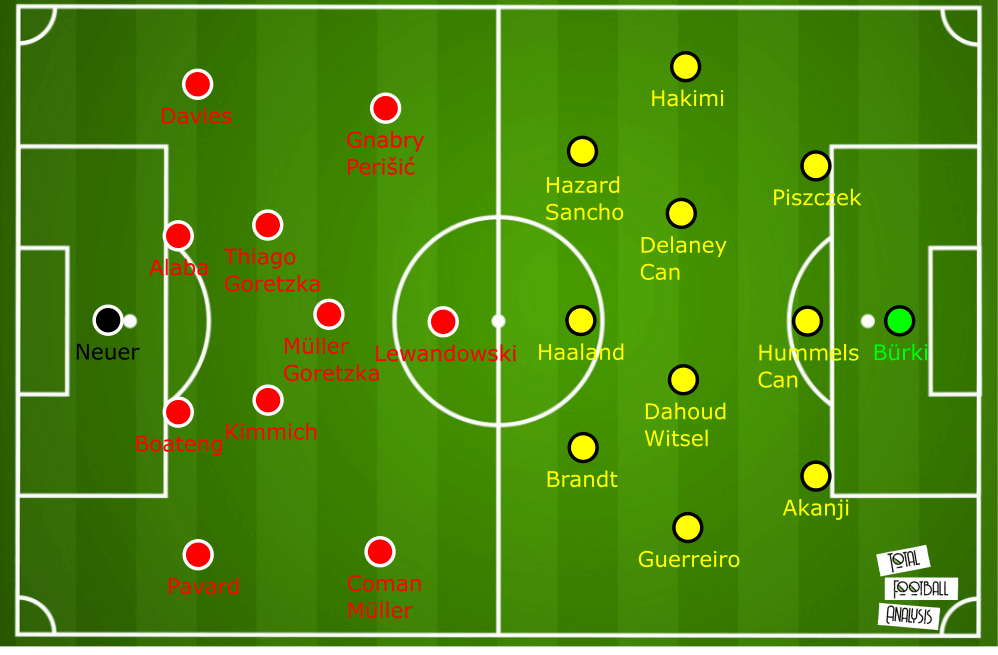
Dortmund’s 3-4-3 during the first stages of the build-up
One of the most interesting questions ahead of this game is who will dominate the match and which players are able to take control of the game since basically both teams are usually the favourites and dominate the matches with possession. While Dortmund had against Wolfsburg 56% possession and played 251 more successful passes than the opposition (against Schalke 57% and 202 more successful passes), the team of Flick were even more dominant and had in moth matches after the restart at least 65% of possession plus 331 and 328 more successful passes than Union Berlin and Eintracht Frankfurt respectively. Here you need to note that Bayern had slightly weaker opponents, but still, we can see that both dominated their matches and also won all of them.
Now, we will focus on Dortmund’s tactics and positionings during the build-up. They stay in their 3-4-3 formation and the back-three is responsible for the circulation of the ball. The two central midfielders stay narrow and quite deep while the wing-backs hug the touchline to stretch the opposition. The two wingers have a lot of freedom and position themselves mainly in the half-spaces at this stage. All these aspects can be seen in the shot below.
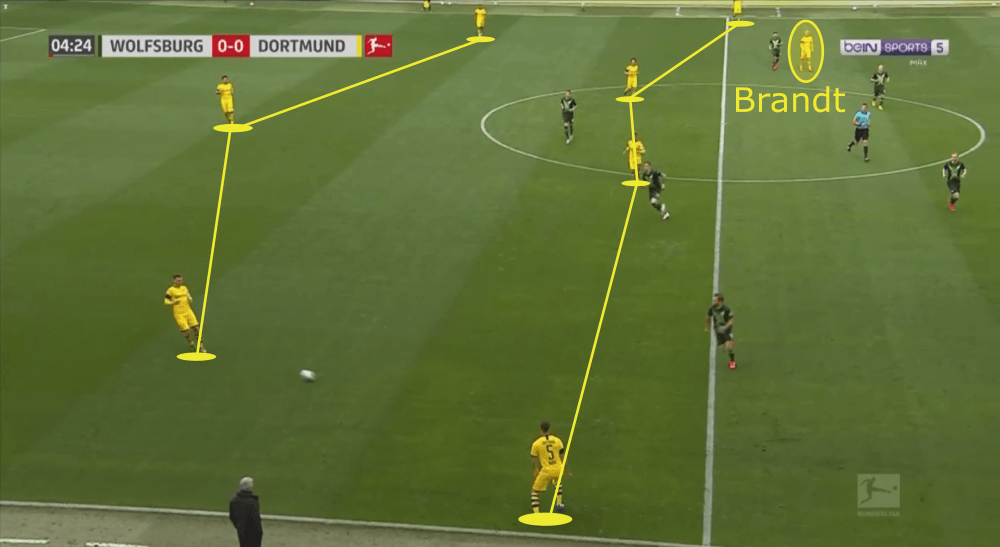
The progression of the ball mainly happens with the aid of vertical balls to break the opposition’s lines (mainly towards Brandt and Hazard) and little interplays in the half-spaces and on the wing. Even though Schalke and Wolfsburg both tried to occasionally use a high press, BVB stayed calm and continued to use the combination of short passes and rotations to get forward.
We could also often see that one of the outer men of the back three take the ball and dribble forward to provoke that an opponent would step out what should then open up a passing lane. At this stage an important principle of Dortmund comes into play: one player stays near the touchline while another one is positioned in the half-space. Logically it is more often the winger who is in the half-space, but they also often interchange position with the wing-backs. Because of their positioning, the player who puts pressure on the defender on the ball (in the image below Akanji) can’t put both men into his cover shadow and one man gets free. In the example below Guerreiro is the free man, receives the ball from his Swiss teammate and then instantly tries to have a give and go with Brandt (who is in the half-space).
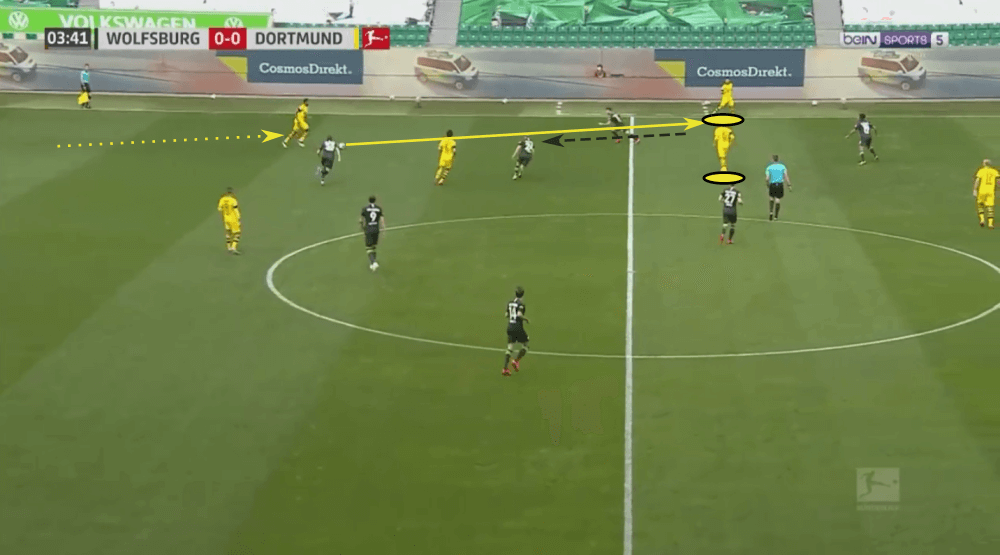
As already mentioned above in this tactical analysis, one central aspect of Favre’s tactics in their 3-4-3 is that the two wingers have quite a lot of freedom and shouldn’t stay near the touchline since then they would be in the same vertical zone as the wing-backs and therefore they would lose one passing option on each wing. Of course, when you use such flexible tactics and patterns, it is important that you have players in these positions who can handle these tasks and have the ability to look for and find free spaces.
Especially Brandt is the perfect man for this position and you can find him all over the place as we can see in his heatmap for the game against Schalke below (the top one). Meanwhile, Hazard also likes to exploit his freedom, but rarely drops as deep as Brandt and stays more in his right half-space near Haaland. This gets visible in his heatmap below in the game versus Schalke (bottom one).
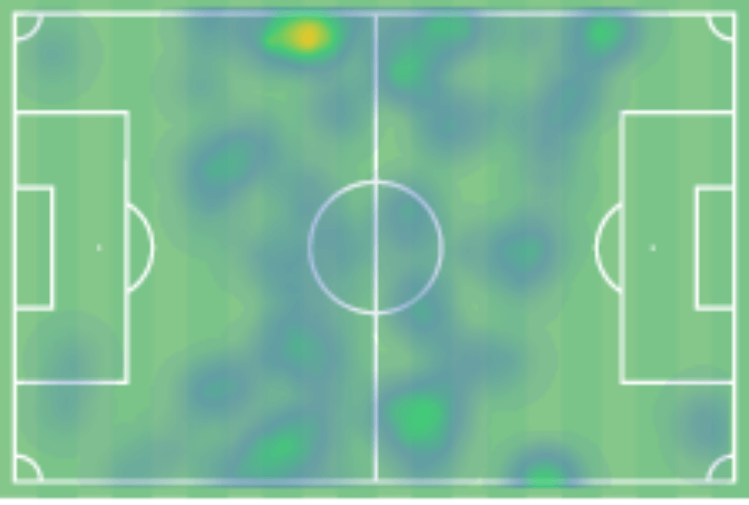
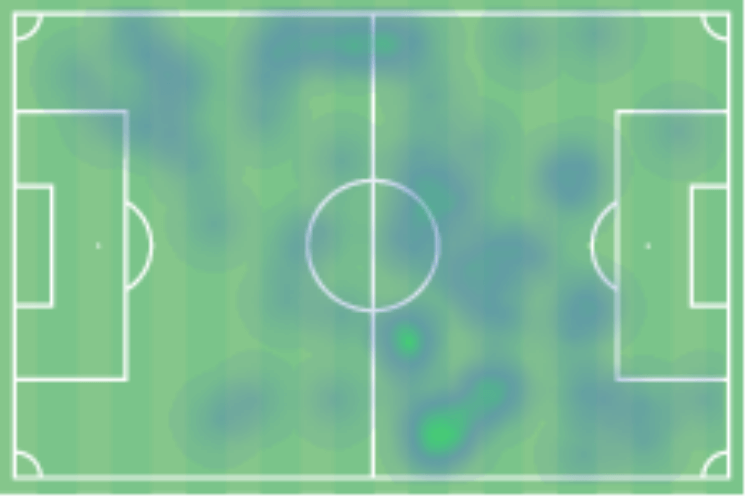
The aspect that Brandt drops more frequently deeper to help the two central midfielders during the first stage of the build-up can also be seen in the passing stats since Brandt played in the two games since the restart combined 103 passes (86 successful ones) while Hazard passed the ball 61 times and 44 of the balls found a partner.
Anyways, this deep positioning of Brandt also brings the opponents often in a bad situation as the players need to decide who should mark him. Especially Schalke had huge problems (they played in a 5-4-1 and so there was a two-on-two in the centre without Brandt dropping) when the young German came deeper since then they had a numerical disadvantage. Due to that either one of the centre-backs followed him (what created a gap in the defence in which Brandt or Guerreiro sprinted) or the central midfielders had to try to mark together three players of Dortmund.
Because of that, the right central midfielder Weston McKennie often found himself in a bad situation as he had to look after Brandt and Delaney at the same time.
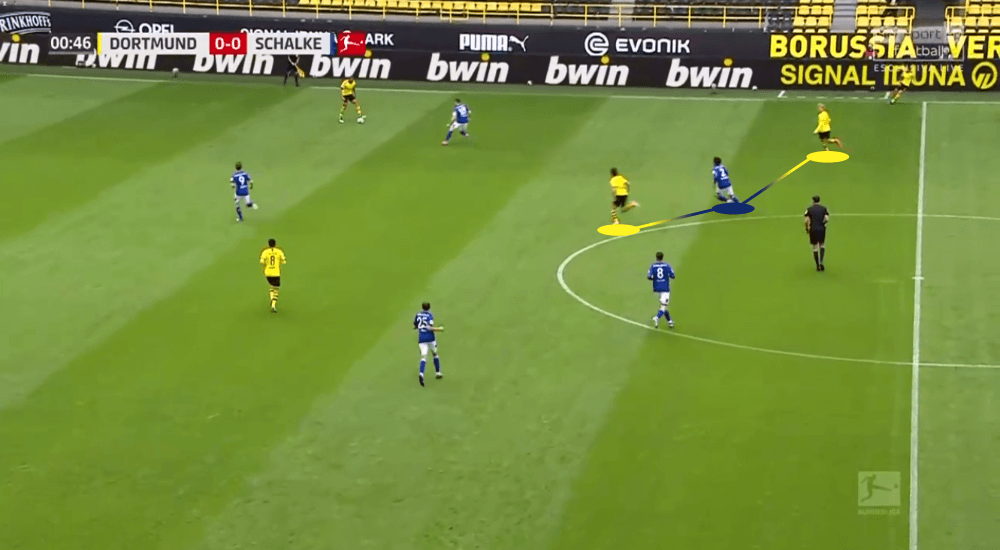
Favre’s team in advanced areas
When Dortmund’s opponent sit back deeper or Favre’s team are able to bypass the press there tactics and positionings logically slightly change even though interplays are still the most important pattern to break through.
Basically, the wingers still have a lot of freedom and often occupy the half-spaces while Haaland stays central and the wing-backs provide width. Also, we can often see that one of the two central midfielders goes slightly forward while the other one stays near the back three and they are the ones who should provide a secure option for a back pass. In the shot below we can see how Dahoud stays deeper while Delaney joins Brandt in a higher line and the wing-backs (Hakimi out of the frame) stay wide.
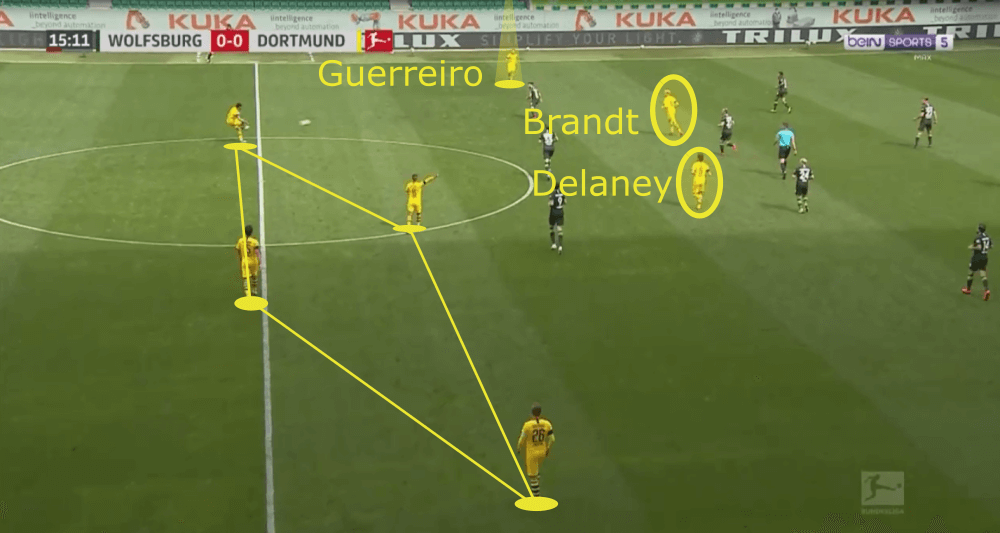
Anyways, the positioning of the three forwards is as during the build-up extremely variable. The central task is to give the player on the ball enough options for a pass, to create overloads and use the combination of short dribbles and passes to get into a dangerous area.
Due to that, it’s also not rare to see situations like the one below in which Haaland positions in the wide-area and meanwhile Hazard occupies the centre.
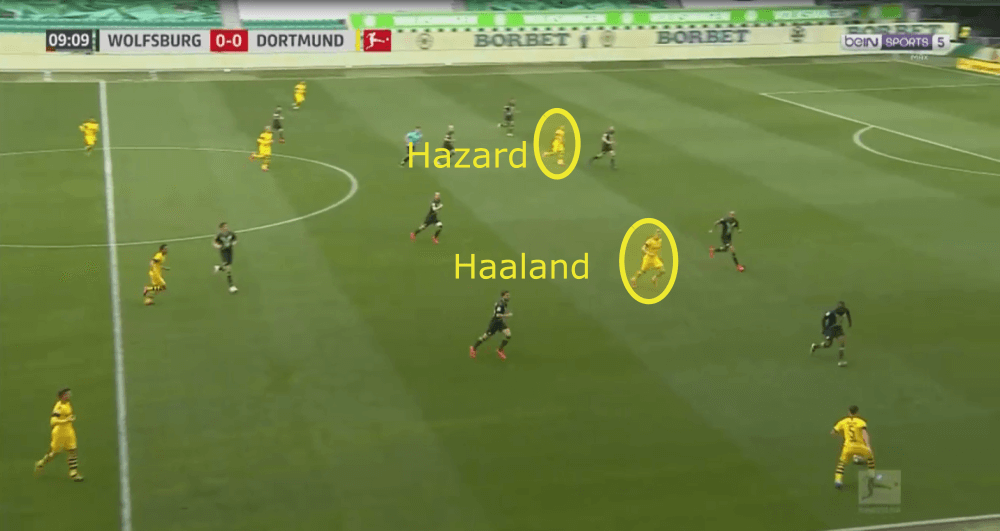
One typical pattern for Dortmund under Favre is that they try to reach the goal line and then deliver a low-thriven ball into the centre (often towards the space around the penalty spot). To get there they use overloads and little give and goes or interplays.
The first goal in their last game against Wolfsburg resulted exactly out of such a situation as we can see in the two images below. At first, they used a little interplay on the right-wing to then bring Hazard in the perfect position for a low cross which can be seen in the second shot. Guerreiro has then just the task to tap it in from a few yards.
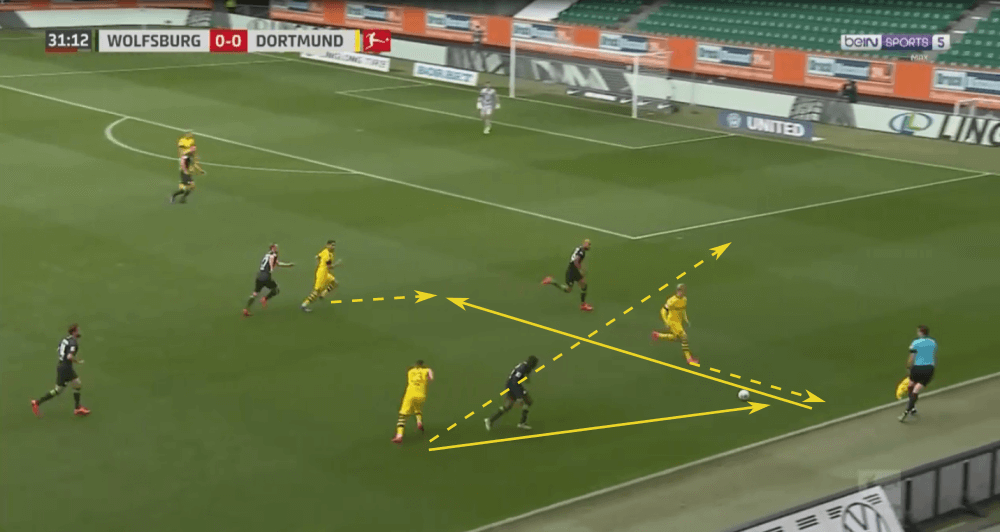
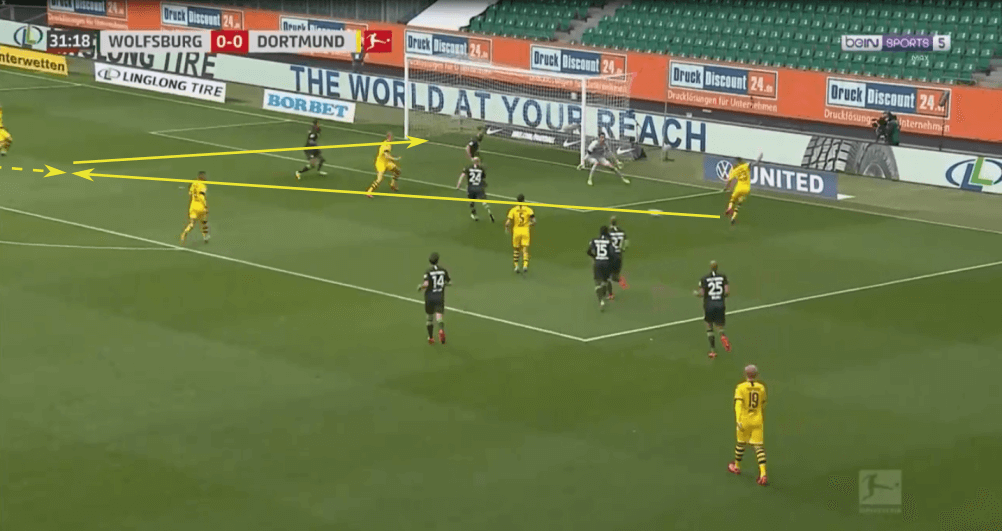
Bayern’s patterns depending on the players
On the other side, Bayern also stay in their 4-2-3-1 formation during the first stage of the build-up. The two centre-backs Alaba and Boateng are both extremely strong on the ball and especially receive support from Kimmich when it comes to the circulation of the ball. The full-backs Pavard and Davies position wide while when an attack goes down the left side the right-back stays deeper and the other way around. In the shot below we can see their 4-2-3-1 during the build-up.
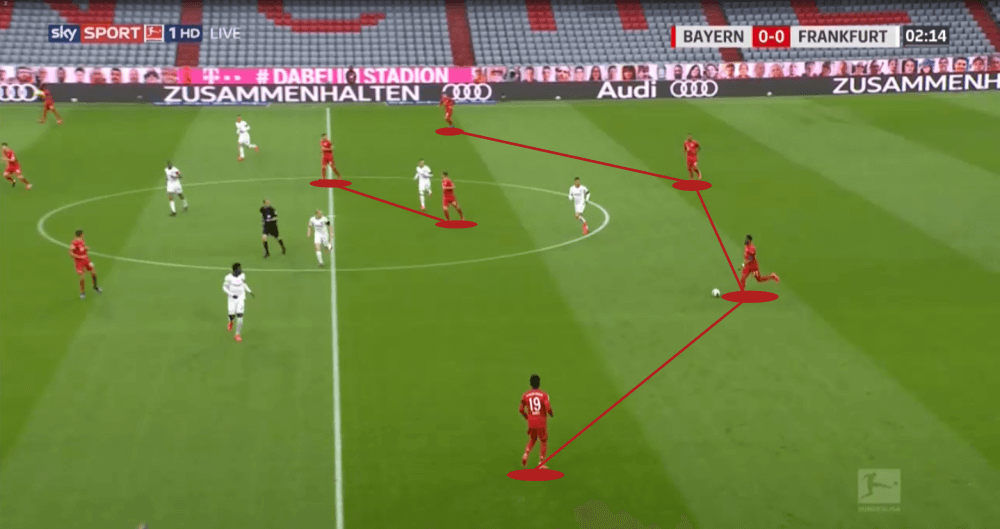
As mentioned, Kimmich is extremely important for their build-up and the progression of the ball. It’s no surprise that he is behind Neuer the Bavarian with the second-most minutes on the field in this Bundesliga season (2394 minutes) and he is in this season the player with the second-most overall passes (1997) behind Sevn Bender (2007). Also, with 12.26 progressive passes per 90 minutes, he is among the best players for this category in Germany’s first tier.
The German midfielder sometimes intelligently drops deeper as we can see in the shot below to get out of the cover shadow of the opponent and generally creates with that movement distance between him and the opponent. We will surely see this occasionally in the game against Dortmund.
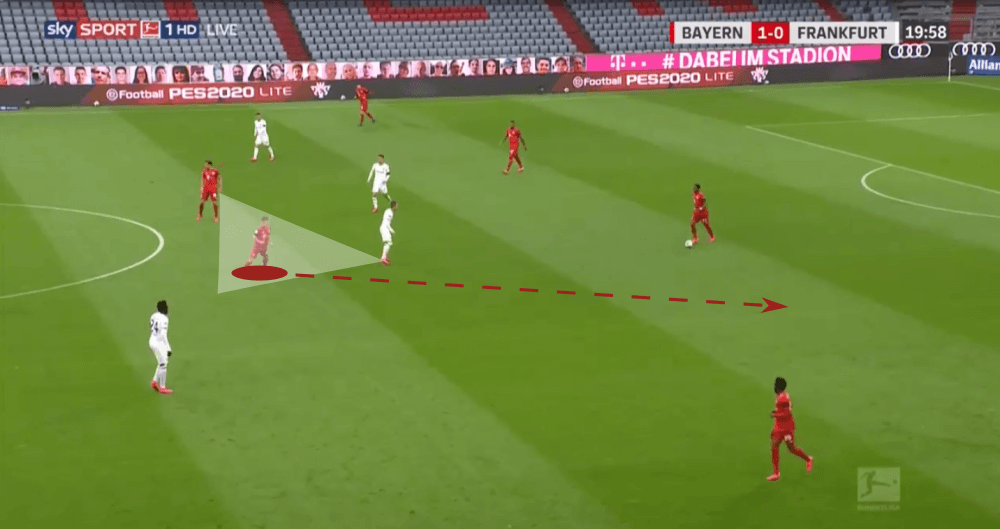
Also, it is extremely interesting to see that Müller is under Flick again one of the most important players for the Bavarian club. Under the prior coach Niko Kovač he was indeed not among the players who were regular starters, but under the German coach, he is a central and important part of the team again.
We have to note here that the two players beside Müller in the offensive midfield are the ones on who the style of play depends. While Coman and Perišić stay near the touchline and stretch the opposition, Goretzka and Gnabry often interchange positions with their teammates and more frequently tuck in to give the full-backs space to rush forward (when Goretzka plays with Gnabry and Müller behind the striker, he is usually the central one while with Coman and Perišić, Müller is in the centre).
Anyways, in the shot below we can see the situation which led to the first goal against Frankfurt and we have the above-mentioned aspects. Coman and Perišić stayed wide while Müller was in the centre and started a run behind the last line of Frankfurt. The Croatian winger let the pass of Alaba through and Müller received it who then delivered a low cross for Goretzka who scored.
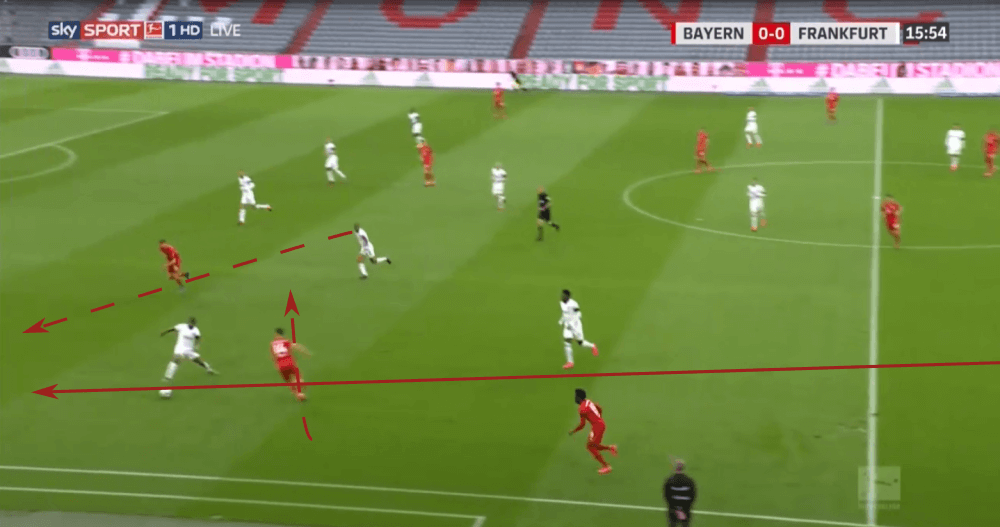
So, we saw in the game against Frankfurt less frequently that their wingers tucked in or that they used rotations while in the match versus Union Berlin Goretzka, Gnabry, Müller and the defensive midfielder Thiago permanently rotated to break up the opposition (who defended incredibly man-orientated). In the shot below we can see an example for this rotation.
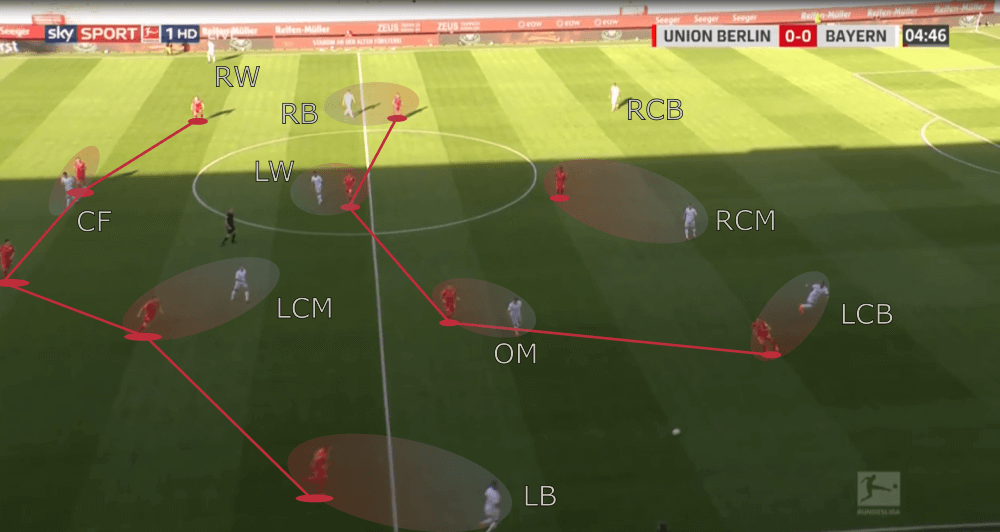
One decisive and interesting duel in the match between Bayern and Dortmund is the one between Bayern’s left-back Davies and the right wing-back of Dortmund, Hakimi. Both are among the fastest players of the Bundesliga and like to rush forward down the wing. Especially Flick’s side love to exploit the speed of the young Canadian on the left side as we can see in the example below. Anyways, it will be interesting to see if Hakimi can stop his opponent and how effective Dortmund’s attacks down their right side will be.
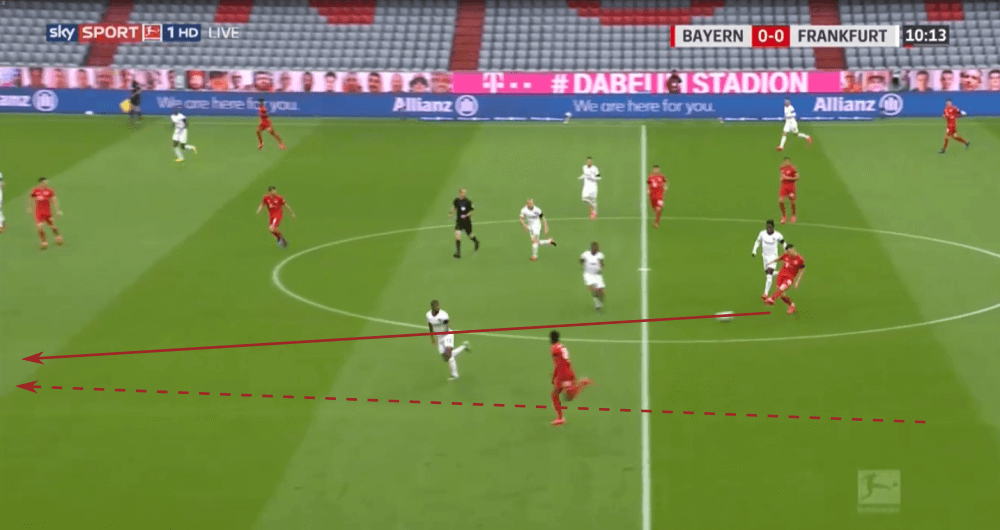
Both teams’ tactics out of possession
We now talked a lot about the tactics of both sides in possession and will now shortly discuss how they act when they don’t have the ball. Since both teams dominate usually their games, we don’t see that much counter-attacks, but the moments of offensive transition could be quite important in the direct clash since not both teams can permanently press and will also have to sit back and defend deeper in some periods. That creates space for counter-attacks. Anyways, we will focus on the remaining part of this tactical analysis and preview on their (counter-)press.
Dortmund didn’t use such an intense press against Schalke and Wolfsburg. They varied their pressing height, but rarely put pressure on their opponents with full intensity high up the pitch, but often sat back a bit deeper as we can see in the shot below. The wing-backs, as well as the wingers, then dropped deeper to created mainly a 5-4-1 formation.
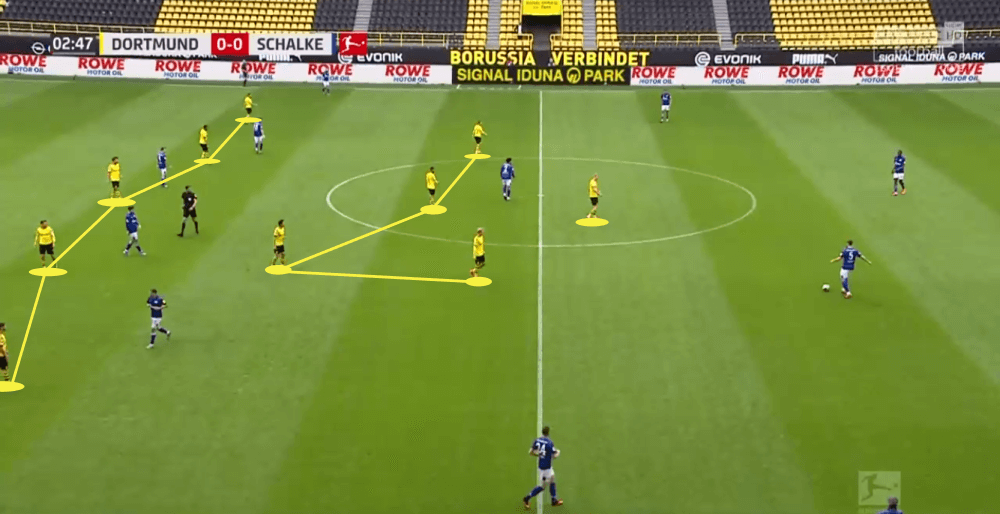
Anyways, Guerreiro didn’t permanently drop deep on the same height as the back three and due to that they also created sometimes a 4-5-1 with the Portuguese as a left-winger. I expect against Bayern that they will switch between these two formations depending on the positioning of Hakimi and Guerreiro as we can see below.
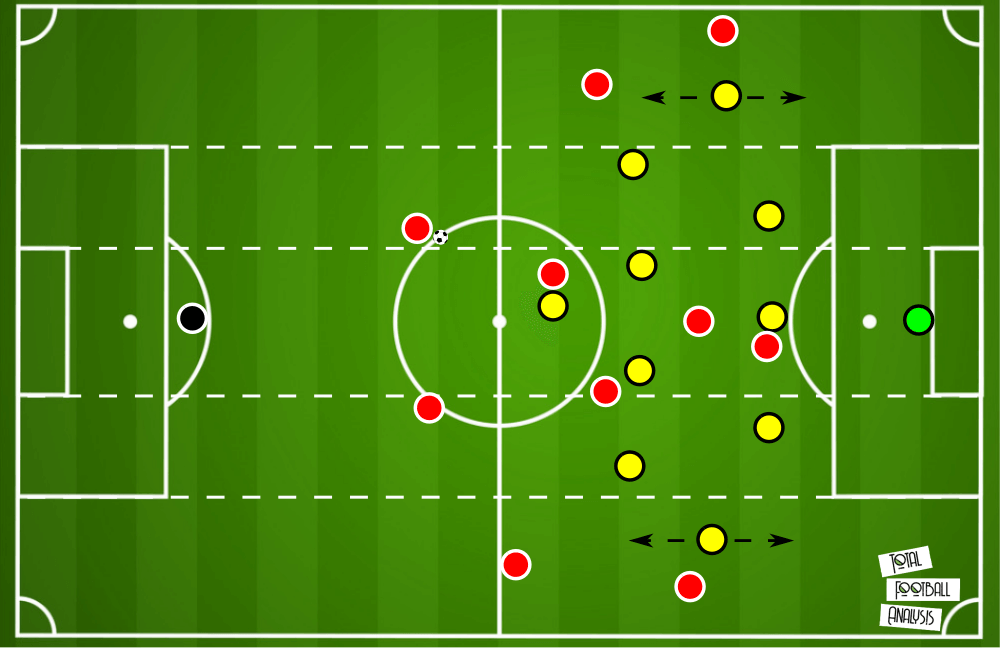
Even though Favre’s team didn’t permanently press in at the opponents high up the pitch, we occasionally saw them executing a solid counter-press in which also the defenders played a central part as they needed to step forward and put pressure high up the pitch on their opponents.
However, while Dortmund rarely pressed in at their opponents aggressively high up the pitch, Flick’s side did exactly that in their last two games. We can also see that in the values for PPDA (passes per defensive action) as Bayern had the numbers 7.3 and 7.6 while Dortmund had the values 12.3 and 16.5.
Lewandowski was especially supported by the wingers and the central offensive midfielder marked the opposition’s central option(s) behind the Polish striker.
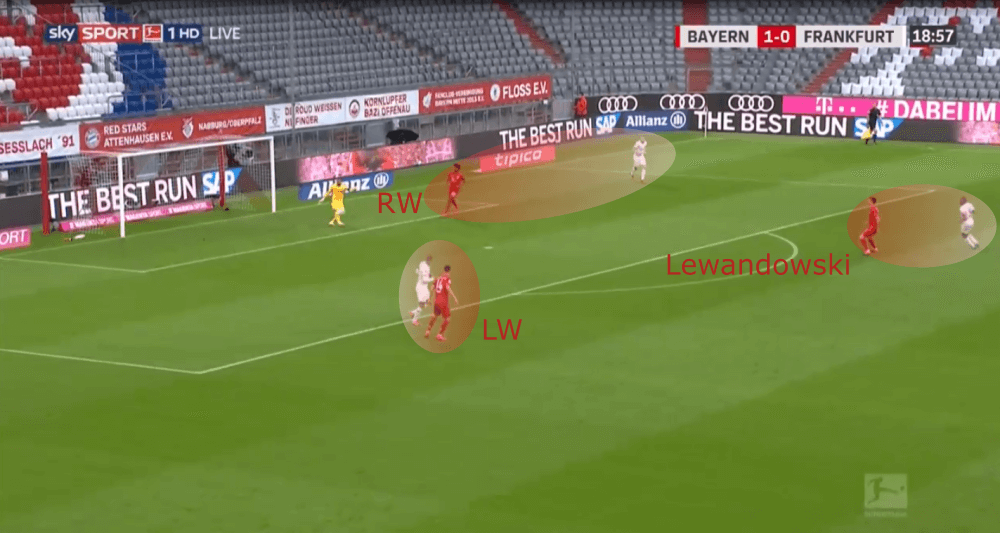
Conclusion
All in all, it will be interesting to see which team will dominate the game and how Dortmund will try to bypass the pressing of Bayern. Brandt will again be vital for this period of the game, but one central question is also if we will see Sancho or Hazard in the starting eleven. This will influence also Bayern’s behaviour since these are two different types of players and Sancho is more dangerous in the final third.
Since Bayern like to dominate the game and Favre’s team defended quite deep in some periods in the last two games, we can also expect to see this in the direct clash. If so, counter-attacks of Dortmund could be deciding moments in this match.
No matter which way this game will go, we will get an interesting clash between two of the best sides in Europe and especially the tactics and ways how they try to reach the final third will be deciding.





Comments